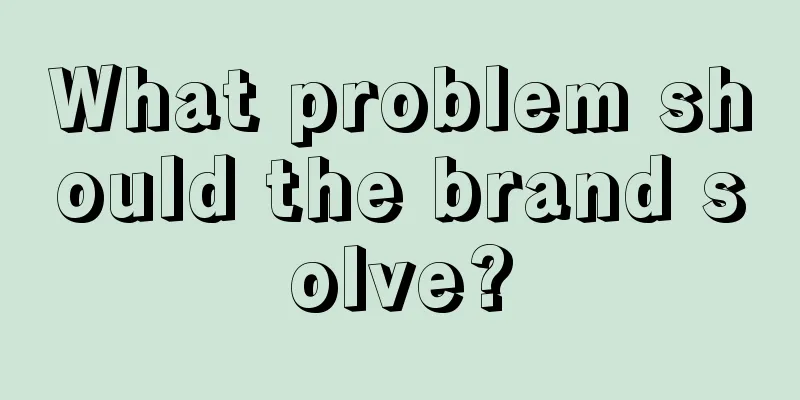Don’t be a third-rate brand. Dismantle the brand assets of Lego and Patagonia

In the digital age, how can brands accumulate brand assets and ultimately achieve business growth? This is a common problem faced by both start-up and mature brands. This article provides brands with a growth guide in the digital age from three aspects: brand assets, brand growth stages, and brand growth paths. It is hoped that it will help brands with their digital transformation and business growth. To some extent, brand and growth are two sides of the same coin and are an either-or relationship. We have been on the road of seeking synergy for a long time. The Opportunity·Knife Skills Annual Brand Effectiveness Summit invited Dr. Cao Hu, global partner and president of Greater China and Singapore of Kotler Consulting Group, to give a keynote speech on "Methodology of Brand Growth in the Digital Age". This sharing session mainly discussed how to re-understand brand assets in the context of a rapidly changing era, drive brand asset accumulation through refined operations, and ultimately achieve business growth? (1) Rethinking Brand Equity: Most attempts to build relationships with consumers ultimately fail (2) The brand foundation beneath the surface: the four-stage value chain of brand growth (3) How to transform brand into growth? Four new paths to achieve digital brand building The following are some excerpts from Cao Hu’s sharing, which I hope will be helpful to marketers and traders. Hello everyone, I am Cao Hu from Kotler Greater China and Singapore. Almost everyone here deals with brands every day, but I believe that everyone has a different definition of brands. In my opinion, brand is like love, seemingly invisible and intangible. We discuss and talk about it in different languages, but when it really comes, you can feel the throbbing of your heart at that moment. In fact, the brand is not in our company, it is in the hearts of consumers. 1. Most attempts to build relationships with consumers ultimately failIn English, the process of building a brand is called "Branding", which can be broken down into "Brand+ing". The present continuous tense indicates that this is actually a continuous process of creation and management. Therefore, the difficulty of brand building is that it cannot be achieved overnight. There is no such thing as "achieving success in one battle". It requires long-term investment, continuous construction, and constant attention to the development and changes of reality. Otherwise, a customer complaint, a failed new product, an unreasonable customer service reply... may lead to the loss of years of accumulated brand goodwill. After years of careful and careful cultivation, you will finally obtain "brand assets" or "brand equity". What exactly is brand equity? Brand expert Kevin Keller has given a relatively clear definition: "The differentiated response of customers to marketing activities caused by brand knowledge" is "brand equity". "Brand knowledge" is the key word here. The content we often mention, user experience, founder stories, super materials, business models, event sponsorship, spokesperson selection, etc. are all included in "brand knowledge". What we mean by branding is the process of continuously building brand knowledge that is relevant, valuable, differentiated and unique to consumers. This knowledge will greatly change consumers' perception of related products. This differentiation, when reflected in business, is transformed into indicators such as brand premium, brand loyalty, customer love in back-end operations, customer referrals, and customer lifetime value. This also explains why, based on the same thirst-quenching function, the product of mineral water shows more than 5 times difference in price range. In the past, brand communication treated consumers as prey. The grandiose marketing theories were actually hunting manuals, teaching you how to set traps and capture targets. At that time, brand building was like a competition of who could speak louder with a portable megaphone. The louder the voice, the wider the information spread. Consumers also tended to buy products they had "heard of", even if they were not necessarily the most suitable for them. But today’s brand equity model is no longer based on the company’s communication trajectory, but a distributed existence centered on customers. This is the “customer-based brand equity model” proposed by Kevin Keller in “Strategic Brand Management”. Through this pyramid model, we can see several key points: First, distinctiveness is the cornerstone of brand assets. A brand without distinctiveness is like a tree without roots and water without a source. In the past, the creation of uniqueness mainly relied on advertising, but today it can be achieved through a variety of methods such as content seeding and social interaction. The next question is - what does this brand mean to consumers? What problems can it solve? A brand is committed to becoming an expert in the industry and helping you solve efficiency problems. Many technology brands are in this category. Another type of brand focuses on meaning, making "me" a "better me" and helping consumers move to a higher level. From "what does it have to do with me" to "it's about me", consumers are willing to recommend trustworthy brands to more people. Second, how to establish a relationship between consumers and brands is the biggest challenge and opportunity we face today. Consumers only care about their own lives and how to face challenges to become better versions of themselves. They don’t care about brands and rarely care about products. They only think of brands when they need to use external objects to “express themselves.” However, once you successfully establish an irreplaceable relationship with consumers by building authenticity and creating values, consumers will reward you with loyalty, repeat purchases, recommendations... and even actively integrate into the brand by considering themselves as one of its members. But the sad fact is that the vast majority of attempts to build relationships with consumers ultimately fail, and can only rely on supply chain and price-performance ratio to achieve growth. 2. Giving up core assets will only reduce the brand to a third-rate brandAs we all know, LEGO is one of the most popular brands among consumers worldwide, but it has also faced huge challenges in the process of brand management. More and more children are born into the "electronic world" and spend a lot of time playing online games and electronic controllers. Compared with electronic games, it sounds boring to spend dozens of hours alone to complete the construction of traditional building blocks. So, when LEGO faced a rapid decline in performance, it tried to catch up with the trend by developing games and promoting new products, but none of them were successful. Later, LEGO learned from its mistakes and finally realized that the key to the problem was not the change in market trends, but a return to its essence - the reason why the brand is loved is precisely because it "unchanged" serves those who are willing to spend time building LEGOs no matter what, and this is the foundation of its survival. If LEGO abandons its core group and its century-long commitment, the end result of chasing the craze will be to become a second- or third-rate brand. What remains unchanged is the “most important customers”; what changes are their new demands and expectations for brands in the digital age. After experiencing hesitation at the beginning of this century, Lego finally confirmed its brand belief - giving builders dreams. When you build a huge castle or aircraft carrier through your creativity, hands and patience, the sense of accomplishment is unparalleled. Taking history as a mirror, we see in the story of Lego that a brand is an iceberg. The cool TVC and brand communication are only the 20% floating on the water. The 80% below the water is the daily work of brand people - brand positioning, brand mission, brand essence, and brand vision. This is the foundation of the brand. Don’t build a brand just for the sake of building a brand. The brand must be highly linked to the marketing strategy and growth strategy. Brand growth does not necessarily come from technological innovation, but often also from structural adjustments to the business, as well as re-examining and truly delivering the brand promise. The different stages of growth from a super niche brand to a national brand correspond to different shaping and focus points. Brand assets will also present different patterns as the stages develop. In the early stage, it is customer expansion, and in the later stage it will turn into repeat purchases, recommendations, and breaking the circle. The strategic core of a startup brand must be to start from the marginal categories, and first attract the most passionate and relevant consumers by innovating product functions or focusing on niche groups, cut into the market dominated by giants from corners ignored by large companies and big brands, and then break through the circle with the help of the maturity of the crowd to achieve growth in the number of SKUs, until a monopoly position is occupied in the segment. If you want to grow from a niche brand to a category brand, the top priority becomes to expand the category appropriately. If the product line cannot keep up with the development, the opportunity to contact with customers will be reduced, making it difficult to extend LTV. When you have successfully become the leader in a category, you must expand to multiple categories and brands. The core issue at this time is no longer low-dimensional competition such as products and functions, but the shaping of higher dimensions such as emotions, trust, and values. Just like Coca-Cola never promotes zero sugar and zero calories, Apple always emphasizes "Different". 3. Brand assets that cannot be converted into growth are like real estate that cannot generate cash flowKotler Consulting divides brand assets into two categories according to their business functions: one is kinetic assets and the other is potential assets. Momentum can drive the sales curve to steepen quickly, increase channel penetration, and get the best position in offline channels. The latter represents the leadership and appeal of the brand, making consumers look up to it and want to become a part of the brand. Potential energy brings brand premium and customer loyalty, allowing brands to "sell at a higher price", lower customer churn rate, and higher customer lifetime value. The fission efficiency brought by spontaneous recommendations from customers is much higher than that of the B-end. The core of brand growth is to deconstruct and transform "brand assets" into growth drivers and marketing strategies to guide the company's marketing practices. First of all, the most direct commercial value that brand assets bring to enterprises is high penetration. If only one indicator can be chosen to measure whether a brand manager is qualified, it depends on whether the brand's penetration rate among customers has increased after a large budget has been invested. If not, it means that the cost is inefficient or ineffective. The second is high recommendation and high repurchase. When customers identify with the brand's philosophy, find a sense of belonging to the community, and are willing to buy repeatedly themselves and recommend friends to buy, they have actually transformed their love for themselves into love for the brand. As brands enter today's changing era, the uncertainty of the overall environment has increased and black swans have appeared frequently, but the following four paths are still effective ways to build brands. First, starting from values. There is no doubt that we live in a society where values are increasingly divided. The reason why Allbirds and Patagonia can be at the top of the contempt chain is that they grasped the highest level of brand emotion from the beginning and attracted a group of seed users who are highly sticky and willing to follow. In layman's terms, the value Patagonia demonstrates is "Don't buy outdoor clothing every day" because these fabrics and production processes will produce pollution that the earth cannot eliminate. A true outdoor sports enthusiast will only hope that the earth's environment will become better. In contrast to other brands that use marketing and promotions to encourage excessive consumption, Patagonia sacrifices short-term business returns but creates more respectable long-term value. Brands must be responsible. Only by bravely saying NO to certain things can your YES become valuable. A truly great brand is a sincere, kind, and trustworthy partner. Consumers are getting smarter and disguised brand concepts will definitely be seen through. As Mr. Kotler said, "The right things have long been written in books by the sages. What we lack is the courage and ability to do the right things." Second, tell a good brand story. Stories are the basis for communication and exchange between people and can generate infinite power. But today, the core of storytelling is no longer "how awesome I am", but "touching you". The core of Lululemon's brand is the founder's consistent praise for beautiful bodies and indomitable sports spirit. A sincere brand narrative must come from life and the inner world of the founder himself, so that it can eventually become the embodiment of dreams. Third, focus on scenario mining. The innovation of mature categories comes from discovering new problems and creating new scenarios. Only by restoring the scenarios can we directly meet the needs. A food research institute once released "27 scenarios for eating nuts". Today, the opportunity for large-scale consumption penetration is hidden in the new scenarios in life and the new needs behind the new groups of people. Fourth, jump out of 2B and directly reach 2C. Technology companies should not be limited to the 2B perspective. Jumping to a wider range of consumers to be recognized and familiar can help promote the formation and deepening of B-side value. The most typical case is the creation of "element brands" by Intel, Leica and Dolby. IV. SummaryThe essence of the digital age is to make it possible to "connect customers for life". Consumers are no longer short-term prey, but partners in brand co-creation. After the epidemic, consumers have rethought the meaning of life, and their understanding of rigid needs has also changed. In the foreseeable future, emotional consumption, healing consumption, and slow consumption in the Chinese market will gradually become mainstream. The world is changing but the essence is eternal. Adhere to the "never-ending innovation of customer value" and realize the value promise of the brand to consumers. The world will eventually reward everyone who is patient. "Breaking the Boundary·2024 Knife Skills Annual Product Effect Summit" In 2024, after interviewing nearly 300 marketing industry experts, brand founders and front-line operators, Digipont found that marketing change is a foregone conclusion and all brands have the opportunity to win again. Whether it is a white-label, factory brand, famous brand, or brand, what everyone needs, in addition to their own solid brand power and product power, is to continuously enhance their innovative marketing capabilities in line with the context of the times. This summit not only has more than 50 important industry guests and more than 2,000 brand marketers on site, but also representatives from high-quality industry organizations will attend. At the summit, everyone will work together to bridge the information gap in the brand marketing circle, aggregate upstream and downstream industry resources, and help everyone in the industry survive and move forward better. Daofa firmly believes that one person can walk very fast, but a group of people can go further together. |
<<: Inventory of autumn consumption trends: Uncovering the autumn life of contemporary consumers
>>: 11.9 yuan for three cups, can Juewei Duck Neck’s milk tea sell well?
Recommend
Why is the “anti-human” niche track the secret to success for Vlog creators?
In the current fierce competition in the Vlog trac...
How is DHgate.com's cross-border e-commerce business? How can we do it well?
There are still many merchants engaged in cross-bo...
How to optimize the title on Shopee? What are the tips?
As a cross-border e-commerce platform, Shopee has ...
Let’s talk about Xiaohongshu e-commerce again: Breaking the law of “old wine in new bottles” in community e-commerce
This article describes the current situation of do...
How does Amazon view the ranking of US products? How important is it?
Now there are more and more merchants opening stor...
What is the limit of a one-time credit card? How to increase the limit of a one-time credit card?
Credit cards, as a convenient payment tool, have p...
How is the starday platform? What are its advantages?
As the world's third largest economy, Japan ha...
Money never sleeps, here are the live broadcasts that made the most money during the Spring Festival
While we are busy catching up with the Spring Fest...
What abilities are needed for overseas marketing?
To engage in overseas trade, you need to master ce...
Second only to Dior and Chanel, with annual sales exceeding 100 million, how did this perfume brand enter the private domain?
This article uses Jo Malone's private domain o...
How to write an Amazon Spring Festival holiday notice? What templates are there?
Before the Spring Festival holiday, Amazon merchan...
Why are young people so keen on “finding a partner”?
What is the hookup culture? Why do young people lo...
Golden sentences from copywriting, beautiful haiku
Different copywriting can give people different fe...
Coca-Cola "squashed" logo, the brand has its own sense of relaxation
Coca-Cola subverts tradition and launches the &quo...
During graduation season, how can brands differentiate themselves?
This article lists some successful cases and discu...









